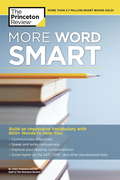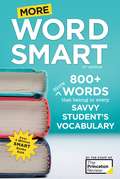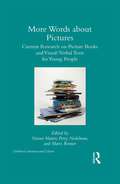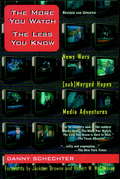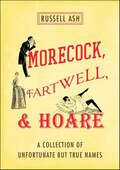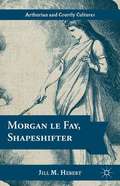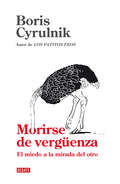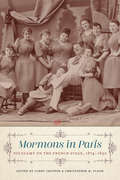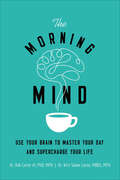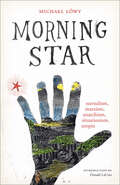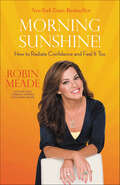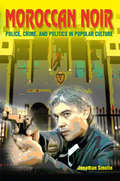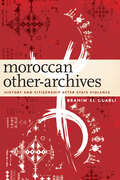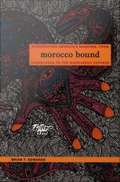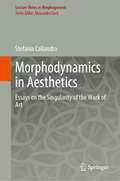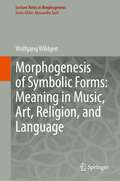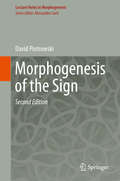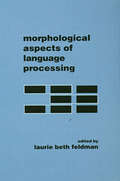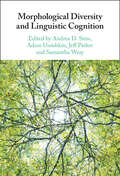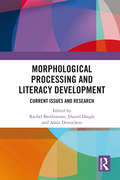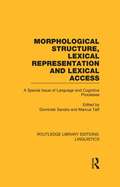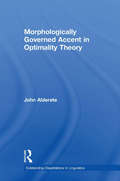- Table View
- List View
More Word Smart
by The Princeton ReviewBuild a More Impressive Vocabulary. Did you know that: • The word "noisome" has nothing whatsoever to do with noise? • "Ordinance" and "ordnance" have two distinct meanings? • An "errant" fool is a fool who is lost, while an "arrant" fool is one whose foolishness is obvious? If any of these facts caught you by surprise, then you need More Word Smart. More than one million people improved their vocabulary with the original Word Smart, but an educated and powerful vocabulary doesn’t stop growing with one book! All of words featured in More Word Smart belong in an impressive vocabulary. Learning and using these words effectively can help you get better grades, score higher on tests, and communicate more confidently at work.
More Word Smart, 2nd Edition: 800+ More Words That Belong in Every Savvy Student's Vocabulary
by Princeton ReviewAN IMPRESSIVE VOCABULARY NEVER STOPS GROWING. More than a million people improved their vocabularies with the original Word Smart, but an educated and powerful vocabulary doesn’t stop growing with one book! Learning and effectively using the words in More Word Smart, 2nd Edition can help you get better grades, score higher on tests, and communicate more confidently at work.MORE WORD SMART includes: • More than 800 more words that belong in every savvy student's vocabulary • Lists of common usage errors • The most frequently-tested words on the SAT and other standardized tests • Lists of helpful word roots • Terms you need to know to understand classic literature, law, and religion
More Words about Pictures: Current Research on Picturebooks and Visual/Verbal Texts for Young People (Children's Literature and Culture)
by Perry Nodelman Naomi Hamer Mavis ReimerThis volume represents the current state of research on picture books and other adjacent hybrid forms of visual/verbal texts such as comics, graphic novels, and book apps, with a particular focus on texts produced for and about young people. When Perry Nodelman’s Words about Pictures: the Narrative Art of Children’s Picture Books was published almost three decades ago, it was greeted as an important contribution to studies in children’s picture books and illustration internationally; and based substantially on it, Nodelman has recently been named the 2015 recipient of the International Grimm Award for children’s literature criticism. In the years since Words About Pictures appeared, scholars have built on Nodelman’s groundbreaking text and have developed a range of other approaches, both to picture books and to newer forms of visual/verbal texts that have entered the marketplace and become popular with young people. The essays in this book offer 'more words' about established and emerging forms of picture books, providing an overview of the current state of studies in visual/verbal texts and gathering in one place the work being produced at various locations and across disciplines. Essays exploring areas such as semiological and structural aspects of conventional picture books, graphic narratives and new media forms, and the material and performative cultures of picture books represent current work not only from literary studies but also media studies, art history, ecology, Middle Eastern Studies, library and information studies, and educational research. In addition to work by international scholars including William Moebius, Erica Hateley, Nathalie op de Beeck, and Nina Christensen that carries on and challenges the conclusions of Words about Pictures, the collection also includes a wide-ranging reflection by Perry Nodelman on continuities and changes in the current interdisciplinary field of study of visual/verbal texts for young readers. Providing a look back over the history of picture books and the development of picture book scholarship, More Words About Pictures also offers an overview of our current understanding of these intriguing texts.
The More You Watch the Less You Know
by Danny Schechter Robert Mcchesney Jackson BrowneA candid insider's tale of how the media really works and why it doesn't work the way it should, The More You Watch, The Less You Know has emerged as a key catalyst in the debate on media reform. The More You Watch, The Less You Know recounts Schechter's media adventures, from when he was "Danny Schechter the News Dissector" on Boston's WBCN radio, to his stints as a producer at ABC's 20/20 and CNN, to his personal odyssey chronicling the anti-Apartheid revolution in South Africa, to his development of innovative programming like South Africa Now and Rights & Wrongs as an independent producer. In this age of telecommunications bills and media mergers, The More You Watch, The Less You Know is an insider's passionate plea for freedom of the (electronic) press.
Morecock, Fartwell, & Hoare: A Collection of Unfortunate but True Names
by Russell AshThere's a baby born every minute and each one has to be named. In this book, you'll find an insanity of nomenclature that beggars belief. Russell Ash has trawled birth, marriage, and death certificates, phone books, and censuses going back centuries to compile a compendium of breathtakingly unlikely-but-true names.Why on earth would Mr. and Mrs. O'Shea name their son Rick? What were the Fants thinking when they named their child Elle? Or Mr. and Mrs. Royd, for that matter, when naming their daughter Emma? Or how about Everard Cock, Page Turner, or Sally Forth? In this painstakingly researched, utterly true, riotously entertaining collection, readers will discover real-life examples of some of the most unusual, crude, and shocking names ever, presenting a laugh-out-loud overview of eccentricity through the ages.
Morgan Le Fay, Shapeshifter
by Jill M. HebertThis study re-examines Morgan le Fay in early medieval and contemporary Arthurian sources, arguing that she embodies the concerns of each era even as she defies social and gender expectations. Hebert uses leFay as a lens to explore traditional ideas of femininity, monstrousness, resistance, identity, and social expectations for women and men alike.
Morirse de vergüenza: El miedo a la mirada del otro
by Boris CyrulnikMorirse de vergüenza nos desvela los secretos de la vergüenza al tiempo que nos ofrece algunas claves para desactivar y superar este sentimiento que tanto condiciona nuestras vidas. La vergüenza es uno de los sentimientos más comunes y más complejos del ser humano. Es una representación mental que toma forma cuando entendemos que también existe el mundo del otro y comenzamos a notar su mirada y a vernos reflejados en ella, pues como decía Charles Darwin «es el pensar lo que los otros piensan sobre nosotros lo que nos hace enrojecer». Basándose en los descubrimientos más recientes de la neurociencia y la psicología Boris Cyrulnik cuestiona la esencia de la vergüenza y explica las razones por las que aparece. Estudia su biología y su psicología, su naturaleza en los animales, en el niño y en el adolescente, su relevancia en el ámbito sexual o familiar, y sus efectos en los supervivientes de grandes masacres o crímenes deguerra. Reseñas:«Boris Cyrulnik es de esas personas que ayudan a vivir [...] En Morirse de vergüenza, un ensayo claro y revelador, el autor analiza este sentimiento, un veneno que mina la existencia.»Le Soir «Cyrulnik arroja luz con el acierto del maestro vocacional.»El Periódico de Catalunya
Mormons in Paris: Polygamy on the French Stage, 1874-1892 (Scènes francophones: Studies in French and Francophone Theater)
by Corry Cropper and Christopher M. FloodIn the late nineteenth century, numerous French plays, novels, cartoons, and works of art focused on Mormons. Unlike American authors who portrayed Mormons as malevolent “others,” however, French dramatists used Mormonism to point out hypocrisy in their own culture. Aren't Mormon women, because of their numbers in a household, more liberated than French women who can't divorce? What is polygamy but another name for multiple mistresses? This new critical edition presents translations of four musical comedies staged or published in France in the late 1800s: Mormons in Paris (1874), Berthelier Meets the Mormons (1875), Japheth’s Twelve Wives (1890), and Stephana’s Jewel (1892). Each is accompanied by a short contextualizing introduction with details about the music, playwrights, and staging. Humorous and largely unknown, these plays use Mormonism to explore and mock changing French mentalities during the Third Republic, lampooning shifting attitudes and evolving laws about marriage, divorce, and gender roles. Published by Bucknell University Press. Distributed worldwide by Rutgers University Press.
The Morning Mind: Use Your Brain to Master Your Day and Supercharge Your Life
by Rob Carter III Kirti Salwe CarterUnleash positive thinking and productive imagination, and flip negative thoughts and behaviors into a lifetime to improve every aspect of your life—each morning, one day at a time.Bad habits. Bad feelings. Bad mornings that turn into regrettable days. Banish them all with simple brain hacks that flip negative thoughts and behaviors into positive, productive ones.The Morning Mind makes it easy. Based on findings from neuroscience and medicine, Dr. Robert Carter and Dr. Kirti Carter help you tamp down on the fear-driven reptile brain and tap into the part linked to thinking and imagination.With topics ranging from diet and hydration to exercise and meditation, you&’ll find ideas for activating your brain—and improving every aspect of your life:Restore healthy cycles of waking and sleepingBlock harmful cortisol hormonesBoost mental performanceCreate calmer morningsDevelop self-disciplineStimulate creativityImprove your leadership skillsInstead of dragging through your day, learn to wake up refreshed, recharge regularly, and live better than ever. From the moment the alarm clock rings, The Morning Mind helps you greet each day with gusto.
Morning, Noon, and Night: Finding the Meaning of Life's Stages Through Books
by Arnold WeinsteinFrom Homer and Shakespeare to Toni Morrison and Jonathan Safran Foer, major works of literature have a great deal to teach us about two of life's most significant stages--growing up and growing old. Distinguised scholar Arnold Weinstein's provocative and engaging new book, Morning, Noon, and Night, explores classic writing's insights into coming-of-age and surrendering to time, and considers the impact of these revelations upon our lives. With wisdom, humor, and moving personal observations, Weinstein leads us to look deep inside ourselves and these great books, to see how we can use art as both mirror and guide. He offers incisive readings of seminal novels about childhood-Huck Finn's empathy for the runaway slave Jim illuminates a child's moral education; Catherine and Heathcliff's struggle with obsessive passion in Wuthering Heights is hauntingly familiar to many young lovers; Dickens's Pip, in Great Expectations, must grapple with a world that wishes him harm; and in Marjane Satrapi's autobiographical Persepolis, little Marjane faces a different kind of struggle--growing into adolescence as her country moves through the pain of the Iranian Revolution. In turn, great writers also ponder the lessons learned in life's twilight years: both King Lear and Willy Loman suffer as their patriarchal authority collapses and death creeps up; Brecht's Mother Courage displays the inspiring indomitability of an aging woman who has "borne every possible blow... but is still standing, still moving." And older love can sometimes be funny (Rip Van Winkle conveniently sleeps right through his marriage) and sometimes tragic (as J. M. Coetzee's David Lurie learns the hard way, in Disgrace). Tapping into the hearts and minds of memorable characters, from Sophocles' Oedipus to Artie in Art Spiegelman's Maus, Morning, Noon, and Night makes an eloquent and powerful case for the role of great literature as a knowing window into our lives and times. Its intelligence, passion, and genuine appreciation for the written word remind us just how crucial books are to the business of being human.
Morning Star: Surrealism, Marxism, Anarchism, Situationism, Utopia (Surrealist Revolution Series)
by Michael LowyAn expanded edition of revered theorist Michael Löwy's Morning Star: Marxism and Surrealism (previously published in French, Portuguese, Spanish, Italian, and Greek), this masterwork collects the author's essays on the ways in which surrealism intersected with a variety of revolutionary political approaches, ranging from utopian ideals to Marxism and situationism. Taking its title from André Breton's essay "Arcane 17," which casts the star as the searing firebrand of rebellion, Löwy's provocative work spans many perspectives. These include surrealist artists who were deeply interested in Marxism and anarchism (Breton among them), as well as Marxists who were deeply interested in surrealism (Walter Benjamin in particular). Probing the dialectics of innovation, diversity, continuity, and unity throughout surrealism's international presence, Morning Star also incorporates analyses of Claude Cahun, Guy Debord, Pierre Naville, José Carlos Mariátegui and others, accompanied by numerous reproductions of surrealist art. An extraordinarily rich collection, Morning Star promises to ignite new dialogues regarding the very nature of dissent.
Morning Star: Surrealism, Marxism, Anarchism, Situationism, Utopia (Surrealist Revolution Series)
by Michael LöwyAn expanded edition of revered theorist Michael Löwy’s Morning Star: Marxism and Surrealism (previously published in French, Portuguese, Spanish, Italian, and Greek), this masterwork collects the author’s essays on the ways in which surrealism intersected with a variety of revolutionary political approaches, ranging from utopian ideals to Marxism and situationism. Taking its title from André Breton’s essay “Arcane 17,” which casts the star as the searing firebrand of rebellion, Löwy’s provocative work spans many perspectives. These include surrealist artists who were deeply interested in Marxism and anarchism (Breton among them), as well as Marxists who were deeply interested in surrealism (Walter Benjamin in particular). Probing the dialectics of innovation, diversity, continuity, and unity throughout surrealism’s international presence, Morning Star also incorporates analyses of Claude Cahun, Guy Debord, Pierre Naville, José Carlos Mariátegui and others, accompanied by numerous reproductions of surrealist art. An extraordinarily rich collection, Morning Star promises to ignite new dialogues regarding the very nature of dissent.
Morning Sunshine!: How to Radiate Confidence and Feel It Too
by Robin MeadeRobin Meade is the poster child for confidence and self-assurance. But the anchor of Morning Express with Robin Meade wasn't always that way. In fact, there was a period in her career when she was plagued with anxiety and panic attacks. In MORNING SUNSHINE, she tells how she overcame her fear of public speaking to go on and achieve her dream of becoming a news anchor. Robin Meade offers her own tried-and-true four-step approach to building confidence. Her trademark warm, personal style translates from the screen to the page in this book, which will give readers even more insight into the young woman who came out of nowhere to become one of the most popular news anchors on television today.
Moroccan Noir
by Jonathan SmolinFacing rising demands for human rights and the rule of law, the Moroccan state fostered new mass media and cultivated more positive images of the police, once the symbol of state repression, reinventing the relationship between citizen and state for a new era. Jonathan Smolin examines popular culture and mass media to understand the changing nature of authoritarianism in Morocco over the past two decades. Using neglected Arabic sources including crime tabloids, television movies, true-crime journalism, and police advertising, Smolin sheds new light on politics and popular culture in the Middle East and North Africa.
Moroccan Other-Archives: History and Citizenship after State Violence
by Brahim El GuabliWinner, 2024 L. Carl Brown AIMS Book Prize in North African StudiesHonorable Mention, 2024 MELA Book AwardsFinalist, 2024 ASA Best Book PrizeMoroccan Other-Archives investigates how histories of exclusion and silencing are written and rewritten in a postcolonial context that lacks organized and accessible archives. The book draws on cultural production concerning the “years of lead”—a period of authoritarianism and political violence between Morocco’s independence in 1956 and the death of King Hassan II in 1999—to examine the transformative roles memory and trauma play in reconstructing stories of three historically marginalized groups in Moroccan history: Berbers/Imazighen, Jews, and political prisoners.The book shows how Moroccan cultural production has become an other-archive: a set of textual, sonic, embodied, and visual sites that recover real or reimagined voices of these formerly suppressed and silenced constituencies of Moroccan society. Combining theoretical discussions with close reading of literary works, the book reenvisions both archives and the nation in postcolonial Morocco. By producing other-archives, Moroccan cultural creators transform the losses state violence inflicted on society during the years of lead into a source of civic engagement and historiographical agency, enabling the writing of histories about those Moroccans who have been excluded from official documentation and state-sanctioned histories.The book is multilingual and interdisciplinary, examining primary sources in Amazigh/Berber, Arabic, Darija, and French, and drawing on memory studies, literary theory, archival studies, anthropology, and historiography. In addition to showing how other-archives are created and operate, El Guabli elaborates how language, gender, class, race, and geographical distribution are co-constitutive of a historical and archival unsilencing that is foundational to citizenship in Morocco today.
Morocco Bound: Disorienting America's Maghreb, from Casablanca to the Marrakech Express
by Brian T. EdwardsUntil attention shifted to the Middle East in the early 1970s, Americans turned most often toward the Maghreb--Morocco, Algeria, Tunisia, and the Sahara--for their understanding of "the Arab. " In Morocco Bound, Brian T. Edwards examines American representations of the Maghreb during three pivotal decades--from 1942, when the United States entered the North African campaign of World War II, through 1973. He reveals how American film and literary, historical, journalistic, and anthropological accounts of the region imagined the role of the United States in a world it seemed to dominate at the same time that they displaced domestic social concerns--particularly about race relations--onto an "exotic" North Africa. Edwards reads a broad range of texts to recuperate the disorienting possibilities for rethinking American empire. Examining work by William Burroughs, Jane Bowles, Ernie Pyle, A. J. Liebling, Jane Kramer, Alfred Hitchcock, Clifford Geertz, James Michener, Ornette Coleman, General George S. Patton, and others, he puts American texts in conversation with an archive of Maghrebi responses. Whether considering Warner Brothers' marketing of the movie Casablanca in 1942, journalistic representations of Tangier as a city of excess and queerness, Paul Bowles's collaboration with the Moroccan artist Mohammed Mrabet, the hippie communities in and around Marrakech in the 1960s and early 1970s, or the writings of young American anthropologists working nearby at the same time, Edwards illuminates the circulation of American texts, their relationship to Maghrebi history, and the ways they might be read so as to reimagine the role of American culture in the world.
Morphodynamics in Aesthetics: Essays on the Singularity of the Work of Art (Lecture Notes in Morphogenesis)
by Stefania CaliandroThis book deals with the complexity of art by focusing on the singularity of the work of art. Gathering a selection of writings in art theory and semiotics, it explores the question of apprehending art from its perceptual aspects to aesthetic comprehension and understanding. Theoretical enquiries focus in particular on the dynamics of the perception of forms, the semiotic value of colour, the aesthetic phenomenon of empathy, the function of vision in relation to other senses and its faculty to lead, in a substantial way, to the embodiment of sense. These theoretical points are constantly observed with reference to the analysis of works of art, especially from the beginning of the modern era, when a renovated psychophysical approach oriented the evolution of contemporary aesthetics. Research into art theories sheds light on how differentials in topologic positions, dimensions, relationships and tones contribute to the arising of forms and colours in perception, and affect the perceiver. The essays presented address in different ways the emergence of sense, by conceiving it as deeply anchored to the dynamics of perception, in addition to the cognitive disposition and knowledge, regardless of whether or not the subject (artist or beholder) is aware of these processes. Through in-depth analyses identifying to what extent the aesthetic moment builds on perceptual and semiotic processes, works of art are revealed to be singularities, reflecting the correlation with morphodynamics in the sciences.
Morphogenesis of Symbolic Forms: Meaning in Music, Art, Religion, and Language (Lecture Notes in Morphogenesis)
by Wolfgang WildgenIn the present book, the starting line is defined by a morphogenetic perspective on human communication and culture. The focus is on visual communication, music, religion (myth), and language, i.e., on the “symbolic forms” at the heart of human cultures (Ernst Cassirer). The term “morphogenesis” has more precisely the meaning given by René Thom (1923-2002) in his book “Morphogenesis and Structural Stability” (1972) and the notions of “self-organization” and cooperation of subsystems in the “Synergetics” of Hermann Haken (1927- ). The naturalization of communication and cultural phenomena is the favored strategy, but the major results of the involved disciplines (art history, music theory, religious science, and linguistics) are respected.Visual art from the Paleolithic to modernity stands for visual communication. The present book focuses on studies of classical painting and sculpture (e.g., Leonardo da Vinci, William Turner, and Henry Moore) and modern art (e.g., Jackson Pollock and Joseph Beuys). Musical morphogenesis embraces classical music (from J. S. Bach to Arnold Schönberg) and political songwriting (Bob Dylan, Leonhard Cohen). The myths of pre-literary societies show the effects of self-organization in the re-assembly (bricolage) of traditions. Classical polytheistic and monotheistic religions demonstrate the unfolding of basic germs (religious attractors) and their reduction in periods of crisis, the self-organization of complex religious networks, and rationalized macro-structures (in theologies). Significant tendencies are analyzed in the case of Buddhism and Christianism. Eventually, a holistic view of symbolic communication and human culture emerges based on state-of-the-art in evolutionary biology, cognitive science, linguistics, and semiotics (philosophy of symbolic forms).
Morphogenesis of the Sign: From Morphodynamics To Neurosciences (Lecture Notes in Morphogenesis)
by David PiotrowskiThis book develops a morphodynamical approach to linguistic and sign structures as an integrated response to multilevel and interrelated problems in semiolinguistic research. More broadly, the content is linked to the realities of living speech through a connection (via the concept of diacriticity) with the Merleau-Pontian phenomenology, and beyond the formal determinations of a semiolinguistic system and its calculus. Such problems are mainly epistemological (concerning the nature and legitimate scope of semiolinguistic knowledge), empirical (concerning the observational device and the data’s composition), and theoretical (regarding the choice of a conceptual and formalized explicative frame). With regard to theory, the book introduces a morphodynamical architecture of linguistic signs and operations as a suitable mathematization of Saussurean theory. The Husserlian phenomenological signification of this formal apparatus is then established, and, from an empirical standpoint, its compatibility with neurobiological experimental results is discussed.
Morphological Aspects of Language Processing
by Laurie Beth FeldmanIt is now well established that phonological -- and orthographic -- codes play a crucial role in the recognition of isolated words and in understanding the sequences of words that comprise a sentence. However, words and sentences are organized with respect to morphological as well as phonological components. It is thus unfortunate that the morpheme has received relatively little attention in the experimental literature, either from psychologists or linguists. Due to recent methodological developments, however, now is an opportune time to address morphological issues. In the experimental literature, there is a tendency to examine various psycholinguistic processes in English and then to assume that the account given applies with equal significance to English and to other languages. Written languages differ, however, in the extent to which they capture phonological as contrasted with morphological units. Moreover, with respect to the morpheme, languages differ in the principle by which morphemes are connected to form new words. This volume focuses on morphological processes in word recognition and reading with an eye toward comparing morphological processes with orthographic and phonological processes. Cross-language comparisons are examined as a tool with which to probe universal linguistic processes, and a variety of research methodologies are described. Because it makes the experimental literature in languages other than English more accessible, this book is expected to be of interest to many readers. It also directs attention to the subject of language processing in general -- an issue which is of central interest to cognitive psychologists and linguists as well as educators and clinicians.
Morphological Diversity and Linguistic Cognition
by Andrea D. Sims Adam Ussishkin Jeff Parker Samantha WrayMorphological structures interact dynamically with lexical processing and storage, with the parameters of morphological typology being partly dependent on cognitive pathways for processing, storage and generalization of word structure, and vice versa. Bringing together a team of well-known scholars, this book examines the relationship between linguistic cognition and the morphological diversity found in the world's languages. It includes research from across linguistic and cognitive science sub-disciplines that looks at the nature of typological diversity and its relationship to cognition, touching on concepts such as complexity, interconnectedness within systems, and emergent organization. Chapters employ experimental, computational, corpus-based and theoretical methods to examine specific morphological phenomena, and an overview chapter provides a synthesis of major research trends, contextualizing work from different methodological and philosophical perspectives. Offering a novel perspective on how cognition contributes to our understanding of word structure, it is essential reading for psycholinguists, theoreticians, typologists, computational modelers and cognitive scientists.
Morphological Processing and Literacy Development: Current Issues and Research
by Rachel Berthiaume Daniel Daigle Alain DesrochersSynthesizing a range of studies on morphological processing from the past 30 years, this edited collection presents the current state of knowledge on morphological processing and defines classroom practices to help students conceptualise the role of morphology in reading, spelling, and vocabulary development. Research has increasingly indicated the importance of morphological tasks in relation to reading, spelling, and vocabulary acquisition in the classroom. Chapter authors present the theoretical considerations guiding morphological processing research to date, address the use of morphology with reference to different populations of learners, and propose effective and innovative instructional strategies for integrating morphology in the classroom.
Morphological Structure, Lexical Representation and Lexical Access: A Special Issue of Language and Cognitive Processes (Routledge Library Editions: Linguistics)
by Dominiek Sandra Marcus TaftThe main concern of this work is whether morphemes play a role in the lexical representation and processing of several types of polymorphemic words and, more particularly, at what precise representational and processing level. The book comprises two theoretical contributions and a number of empirical ones. One theoretical paper discusses several possible motivations for a morphologically organised mental lexicon (like the economy of representation view, and the efficiency of processing view), and lays out the weaknesses that are associated with some of these motivations. The other theoretical paper offers an interactive-activation reinterpretation of the findings that were originally reported within the lexical search framework. The empirical papers together cover a relatively broad array of language types and mainly deal with visual word recognition in normals in the context of lexical morphology (derived and compound words). Evidence is reported on the function of stems and affixes as processing units in prefixed and suffixed derivations. The role of semantic transparency in the lexical representation of compounds is studied, as is the effect of orthographic ambiguity on the parsing of novel compounds. The inflection-derivational distinction is approached in the context of Finnish, a highly agglutinative language with much richer morphology than the languages usually studied in psycholinguistic experiments on polymorphemic words. Two other contributions also approach the study object in the context of relatively uncharted domains: one presents data on Chinese, a language which uses a different script-type (logographic) from the languages that are usually studied (alphabetic script), and another one presents data on language production.
Morphological Typology
by Gregory Stump Raphael A. FinkelIn this radically new approach to morphological typology, the authors set out new and explicit methods for the typological classification of languages. Drawing on evidence from a diverse range of languages, including Chinantec, Dakota, French, Fur, Icelandic, Ngiti and Sanskrit, the authors propose innovative ways of measuring inflectional complexity. Designed to engage graduate students and academic researchers, the book presents opportunities for further investigation. Readers can also access an online computational tool designed by the authors to conduct further analysis on data sets.
Morphologically Governed Accent in Optimality Theory (Outstanding Dissertations in Linguistics)
by John D. AldereteAlderete examines the influences of morphological factors on stress and pitch accent within Optimality Theory.
